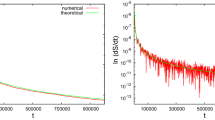Abstract
We show, using semiclassical methods, that as a symmetry is broken, the transition between universality classes for the spectral correlations of quantum chaotic systems is governed by the same parametrization as in the theory of random matrices. The theory is quantitatively verified for the kicked rotor quantum map. We also provide an explicit substantiation of the random matrix hypothesis, namely that in the symmetry-adapted basis the symmetry-violating operator is random.
Similar content being viewed by others
References
M L Mehta,Random matrices, (Academic Press, New York) (1990)
F Haake,Quantum signatures of chaos, (Springer, Berlin 1991)
F J Dyson,J. Math. Phys. (N. Y.) 3, 1191 (1962)
A Pandey,Ann. Phys. (N.Y.) 134, 110 (1981)
J B French, V K B Kota, A Pandey and S Tomsovic,Ann. Phys. (N. Y.) 181, 198, 235 (1988)
A Pandey and M L Mehta,Commun. Math. Phys. 87, 449 (1983)
M L Mehta and A Pandey,J. Phys. A16, 2655, L601 (1983)
A Pandey and P Shukla,J. Phys. A24, 3907 (1991)
T Guhr and H A Widenmüller,Ann. Phys. (N. Y.) 199, 412 (1991)
G E Mitchell, E G Bilpuch, P M Endt and J F Shriner Jr.,Phys. Rev. Lett.,61, 1473 (1988)
N Rosenzweig and C E Porter,Phys. Rev.,120, 1648 (1960)
M V Berry and M Robnik,J. Phys.,A19 649 (1986)
O Bohigas, M J Giannoni and C Schmit, inQuantum chaos and statistical nuclear physics, Eds T H Seligman and H Nishioka (Springer, Berlin, 1986), p 18
A M O de Almeida, inQuantum chaos, Eds H Cerdeira, R Ramaswamy, G Casati and M Gutzwiller, (World Scientific, Singapore, 1990)
N Dupuis and G Montambaux,Phys. Rev.,B43, 4390 (1991)
G Lenz and F Haake,Phys. Rev. Lett.,67, 1 (1991)
G Casati and L Molinari,Prog. Theor. Phys. Suppl.,98, 287 (1989)
F M Izrailev,Phys. Rev. Lett.,56, 541 (1986)
G Casati, L Molinari and F Izrailev,Phys. Rev. Lett.,64, 1851 (1990)
M Tabor,Physica,D6, 195 (1983)
M C Gutzwiller,J. Math. Phys. (N. Y.) 12, 343 (1971)
J Hannay and A M O de Almeida,J. Phys. A17, 3429 (1984)
M V Berry,Proc. R. Soc. (London) A400, 299 (1985)
P Shukla and A Pandey, (in preparation)
Author information
Authors and Affiliations
Rights and permissions
About this article
Cite this article
Pandey, A., Ramaswamy, R. & Shukla, P. Symmetry breaking in quantum chaotic systems. Pramana - J. Phys 41, L75–L81 (1993). https://doi.org/10.1007/BF02847320
Received:
Issue Date:
DOI: https://doi.org/10.1007/BF02847320




